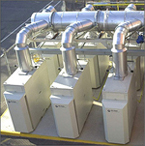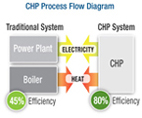
Combined heat and power systems are providing exceptional energy efficiency and emissions reduction across the nation. (Source: UTC Power)
The need for clean, efficient energy for the 21st century is moving a time-tested technology into the limelight. By providing on-site power generation, waste heat recovery, and system integration, combined heat and power (CHP) offers a realistic, near-term solution for exceptional energy efficiency and emission reduction.
As our nation faces growing electricity demand, volatile fuel costs, environmental concerns, and power reliability issues, DOE’s Industrial Technologies Program is working to boost CHP technologies to greater levels of efficiency and further expand the use of this clean energy solution. With proper technical and policy support, the goal of 20 percent generation capacity by 2030 can be achieved, saving approximately 5.8 quadrillion Btu per year, and avoiding 848 million metric tons of CO2 emissions. This is equivalent to removing more than 150 million cars off the road.
HOW CHP WORKS
Combined heat and power (CHP), or cogeneration, is the simultaneous production of electricity and heat from a single fuel source. A CHP system recovers the heat normally lost in electricity generation for use in cooling, heating, dehumidification, and other processes. Compared with separate generation of electricity and heat, CHP systems can operate at more than 80 percent efficiency.CHP is not a single technology, but an integrated energy system that can be modified depending upon the needs of the energy end user. CHP can use a variety of fuels to provide reliable electricity, mechanical power, or thermal energy for industrial plants, universities, hospitals, or commercial buildings - wherever power is needed.
The diagram below compares the efficiency of a combined heat and power system with that of a conventional power plant.

CHP vs. traditional system. (Click on the image for an enlarged view.)
BENEFITS FOR PEAK PERFORMANCE
Compared with separate heat and power production, combined heat and power systems provide a number of benefits, including:•Energy efficiency:CHP systems recycle waste energy and use it for heating and cooling; enhance fuel use efficiency; and increase the benefit to the customer from each cubic foot of natural gas or propane consumed.
•Emissions reduction:Efficient CHP technologies decrease emissions of pollutants and greenhouse gases. What’s more, CHP can use clean, renewable fuels such as biomass or biogas to provide electrical and thermal energy.
•Energy reliability and quality:CHP can operate in parallel with the grid to enhance power reliability and support operations, or supply onsite generating capacity. CHP technologies deliver the high-quality power required by computer systems and sensitive manufacturing processes.
•Energy security:CHP systems can operate independently of the grid to sustain critical services such as health care, communications, shelter, and public safety, after disasters.
•Economic development:CHP systems directly relieve grid congestion, reduce or eliminate power purchases, and avoid the need to construct new power plants. In the case of alternate fuels, CHP systems enable the use of local energy resources and support high-tech manufacturing industries.
•Job creation:Further development of and investment in CHP technologies will generate new jobs for highly skilled, technical workers, and boost local economies.
U.S. COMBINED HEAT AND POWER IN OPERATION
Currently, there are approximately 3,500 CHP sites in the United States, with a generating capacity of 85 GW or 9 percent of U.S. total capacity. This local, clean power generation is reducing annual fuel use by 1.9 quadrillion Btu and offsetting 248 million metric tons of CO2 emissions - equal to removing 45 million cars from the road.Combined heat and power applications span industrial, commercial, and residential market sectors across all 50 states. You can find information on CHP installations in your area by using the DOE-supported CHP Installation Database (www.eea-inc.com/chpdata/index.html), the primary source for tracking CHP sites and market developments. The database provides details for each site on the facility, application, prime mover, capacity, and fuel type.
BREAKING DOWN BARRIERS
Despite its proven benefits, a number of hurdles must be overcome to realize the full potential of CHP in the marketplace. Technical, regulatory, policy, and institutional barriers persist, despite successes at the state and regional level and recent federal legislation to boost tax credits for CHP.ITP is committed to helping overcome these barriers by working collaboratively with U.S. industry and other stakeholders to invest in significant technology improvements, and to transform the market at the federal, state, and regional levels. Ongoing efforts include:
• Increase CHP awareness through DOE’s eight CHP Regional Application Centers, which serve as clearinghouses for CHP information and identify and implement regional CHP projects. The centers’ educational outreach and technical assistance to end-user customers and state policy-makers are instrumental in helping to transform the market for CHP. To date, the CHP Regional Application Centers have assisted in the installation of 350 CHP projects around the country.
• Develop more efficient CHP components, such as advanced turbines, reciprocating engines, and thermally activated technologies, as well as integrated energy systems for new markets at commercial and small industrial facilities.
• Support development of technologies through solicitations to encourage R&D of conventional CHP technologies, as well as those that use alternate fuels. In 2008, DOE issued two separate solicitations for these technology options, which awarded a total of $39 million to selected projects.
• Reinforce partnerships with industry stakeholders, national laboratories, and other federal agencies to develop and deploy CHP. Current partners include: U.S. Environmental Protection Agency; Federal Energy Management Program; New York State Energy Research and Development Authority; U.S. Clean Heat and Power Association; World Alliance for Decentralized Energy; American Council for an Energy Efficient Economy; Northeast-Midwest Institute; and International District Energy Association.
These activities will help to expand the adoption of clean, efficient CHP technologies as a major source of electrical, mechanical, and thermal energy for the United States.
As ITP Program Manager Douglas Kaempf explained, “CHP represents a great near-term opportunity to save energy, reduce carbon emissions, and improve local economies. ITP is taking a lead role in enabling CHP to reach its potential.”
For more information about ITP’s CHP Program, contact Bob Gemmer at bob.gemmer@ee.doe.gov.
Reprinted and adapted with permission from the Winter 2009 issue ofEnergy Matters,a quarterly publication from the U.S. Department of Energy’s Industrial Technologies Program. For the latest issue and archived issues ofEnergy Matters,visit http://apps1.eere.energy.gov/industry/bestpractices/energymatters/.
Publication date:04/06/2009







